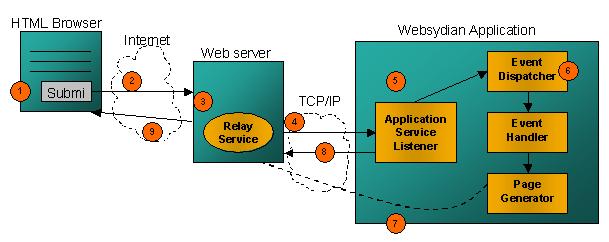|
|
Users Guide | Patterns Reference | WebsydianExpress | Search |
|
|
Users Guide | Patterns Reference | WebsydianExpress | Search |
Introduction Implementing Background
For details on how parameters are passed from the HTML page to the Websydian application please refer to Dispatcher Background. These steps also applies to a Websydian application implemented in one of the DWA variants.
Because of the introduction of a Relay Service component on the web server and an Application Service Listener function some extra steps are needed in order to describe the flow of a request from a browser to the web server.
The flow of a request is illustrated in the figure below.

Each step is described in detail below:
The Relay Service returns the HTML page to the browser.
Please refer to DWA Background for details on how the Relay Service communicates with the Application Service Listener function and how information is exchanged between the two parties.
The Websydian Server is already becoming a central repository for application information, and in future versions of Websydian this development continues, as the Websydian Server gets even more powerful.
Several approaches are used to pass information to the Websydian Server about the application. When starting the Application Service Listener, it is possible to set a number of options, and this information is passed on to the Websydian Server. Also, the Application Service Listener extracts information from the model and passes that information to the Websydian Server.
In order for the Application Service Listener to extract information from the model it is necessary to specify the correct inheritance. How to do that is described in the Implementing section.